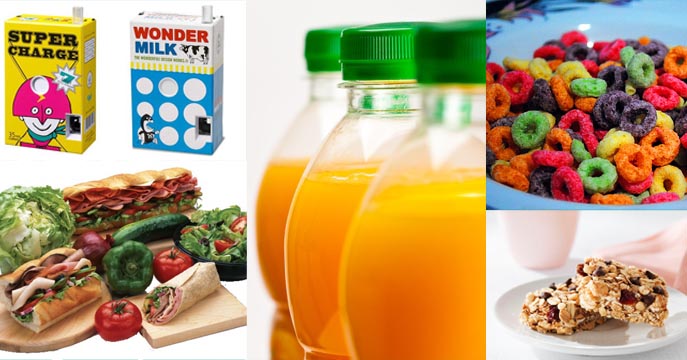
KARACHI: Giving your child a glass of Nesquik and a bowl of Kellogg's Fruit Loops for breakfast, or handing him a Nature Valley peanut butter granola bar for a midday snack are quick and seemingly healthy ways to feed your young 'un. However, unknown to you, these processed foods adversely affect your child’s health and may put him/her at risk of countless problems.
Every food label nowadays screams words like “healthy”, “nutritious”, “wholesome”, etc, especially ones targeted towards kids, but how sure are we that these foods truly contain the au naturel? Well, most of the time the answer is just a box-flip away.
Here's a list of toxic foods that are hazardous to your child’s health, don't stock or feed your kids the following:
1. Breakfast Cereals:
 PHOTO: Well being Wire
PHOTO: Well being WireThe most important meal of the day could possibly be the worst meal you're giving your child. "Breakfast cereals are the single greatest source of added sugars in the diets of children under the age of eight,” said nutritionist Dawn Undurraga, who co-authored the new report, Children’s Cereals: Sugar by the Pound.
According to a 2014 study conducted by Environmental Working Group (EWG), an analysis of more than 1,500 cereals, including more than 180 children’s cereals, showed that a child who eats a bowl a day for a year ends up consuming 4.5 kg of sugar.
EWG’s top 10 sugar-bomb kids’ cereals, ranked by per cent weight in sugar:
Kellogg’s Honey Smacks: 55.6 per cent sugar
Post Golden Crisp: 51.9per cent sugar
Kellogg’s Froot Loops Marshmallow: 48.3per cent sugar
Quaker Oats Cap’n Crunch’s OOPS! All Berries: 46.9 per cent sugar
Quaker Oats Cap’n Crunch Original: 44.4 per cent sugar
Quaker Oats Oh's: 44.4 per cent sugar
Kellogg’s Smorz: 43.3 per cent sugar
Kellogg’s Apple Jacks: 42.9 per cent sugar
Quaker Oats Cap’n Crunch’s Crunch Berries: 42.3 per cent sugar
Kellogg’s Froot Loops Original: 41.4 per cent sugar
Shelving any of the aforementioned cereals? Toss them out, stat! You don't want your child to be linked to diabetes.
Healthy Alternative: Oats (avoid Quaker Oats) with honey and fruits are a great source of nutrition and fiber for your child. Or try different ways of cooking eggs, a definite healthy way to kick start your child's day.
2. “Healthy” Fast Food:
 PHOTO: Downtown Ventura
PHOTO: Downtown VenturaLet’s start off by saying anything that has the label fast food is NEVER healthy, no matter how much the company claims otherwise (fast food salads included). And yes, Subway falls under the unhealthy category, the staple of this franchise is processed meats and cheeses, soft drinks and chips. Consider the study done by NY Daily which states, “People eat more sodium at Subway, with 2,149 mg compared to 1,829 mg at McDonald's.” In a 2013 study published in the Journal of Adolescent Health, researchers found that adolescents who purchased Subway meals consumed nearly as many calories as they did at McDonald’s. Meals from both restaurants are likely to contribute toward overeating and obesity. Be careful next time you decide to treat your kids outside, you might be thinking you're being healthy, but many of the processed foods at fast food restaurants contain high levels of sodium and other preservatives.
Sadly, our favourite go-to ‘healthy dessert’, frozen yogurt is also just as unhealthy as the aforementioned. Sorry to burst your bubble, but according to The Huffington Post fro-yo contains artificial and natural ingredients, and the latter does not necessarily come from places you’d find appetizing (Castoreum, an extract from beaver perineal glands, is used to give natural berry flavors).
Healthy Alternative: Make burgers at home, experiment with different homemade sauces and you'll have yourself an inexpensive and super healthy meal for you and your kids. As for the fro-yo, there’s a simple recipe: some Greek yogurt, a few drops of vanilla extract, banana/ honey/ brown sugar to sweeten, (optional: peanut butter). Mix everything in a blender, pour inside a container, and leave it in the freezer and voila! You have yourself, you very own homemade, healthy frozen yogurt. Top it off with chocolate chips/ fruits/ nuts.
3. Fruit Juice & Milk drinks:
 PHOTO: Soumyajit Blog
PHOTO: Soumyajit BlogSugar, sugar and more sugar! These deceptive boxes which come in colourful and appealing packaging put Hansel and Gretel to shame, not only are they miles away from being healthy or nutritional for your child but The Guardian has labeled them as 'junk food'. A study conducted in 2013 titled Fruit Juice: Just Another Sugary Drink, found that “Fruit juice has a similar energy density and sugar content to sugar-sweetened beverages (SSBs): 250 ml of apple juice typically contains 110 kcal and 6 grams of sugar, and 250 ml of cola typically contains 105 kcal and 26.5 grams of sugar.”
On the other hand, milk drinks, such as Nesquik, contain twice as much sugar as regular milk, except the sugar in regular organic milk is natural. Always remember, if you can store milk in the pantry without it going bad, then it’s obviously not milk.
Healthy Alternative: Freshly squeezed juice or water should be replaced by preservative laden boxes. You can go the extra mile by making smoothies for your kid, that's sure to kick in the necessary nutrients. And look for organic milk that has an expiration date within a week’s time or less.
4. Granola Bars:
 PHOTO: Kashi
PHOTO: Kashi“With all the sugar it contains, just one cup of granola can easily top out at 600 calories, a third of the average woman’s daily allowance,” claims Real Simple. It is one of the unhealthiest of “healthy” snacks you can give to your child. With a 3:1 ratio, it packs more sugar than fiber or nutrients in one bar than your child should be consuming in one meal. Ever wonder how much calories are in The Quaker Oats True Delights Bar? The raspberry and oats chocolate-y goodness contains the same amount of fat and calories as a Snickers bar, even though it’s half the latter’s size.
A physician at the Jacksonville Center for Clinical Research, Dr Booras says, “most of these bars are simply high-calorie cookies and many are no more nutritious than candy bars at a higher price!” With 3 of the most unnatural ingredients - maltose corn syrup, maltodextrin, and sometimes high fructose corn syrup – Nature Valley granola bars are anything but healthy for your child’s consumption.
Healthy Alternative: An apple, trail mix or nuts are a great way to feed your child the goods without packing processed foods and harmful sugars for a snack or school lunch meal.
Although Nestle's rule of thumb is to never buy processed foods with more than 5 ingredients. Here are helpful tips to keep in mind when buying groceries, if you:
- Can’t pronounce it (Butylated Hydroxyanisole… err did their keyboard blow up?)
- Don’t know what it is (Potassium Benzoate, umm, sounds close to potatoes… doesn’t it?)
- Can’t buy it in a store (“Are you looking for Sodium Nitrate? Next to the meat aisle”)
- Wouldn’t stock your cupboards with it (“Mummy, where did you keep the High Fructose Corn Syrup?”)
…reconsider buying it. Remember your choices at the grocery store will inevitably become your child’s choices. Choose very carefully.














































COMMENTS (5)
Comments are moderated and generally will be posted if they are on-topic and not abusive.
For more information, please see our Comments FAQ